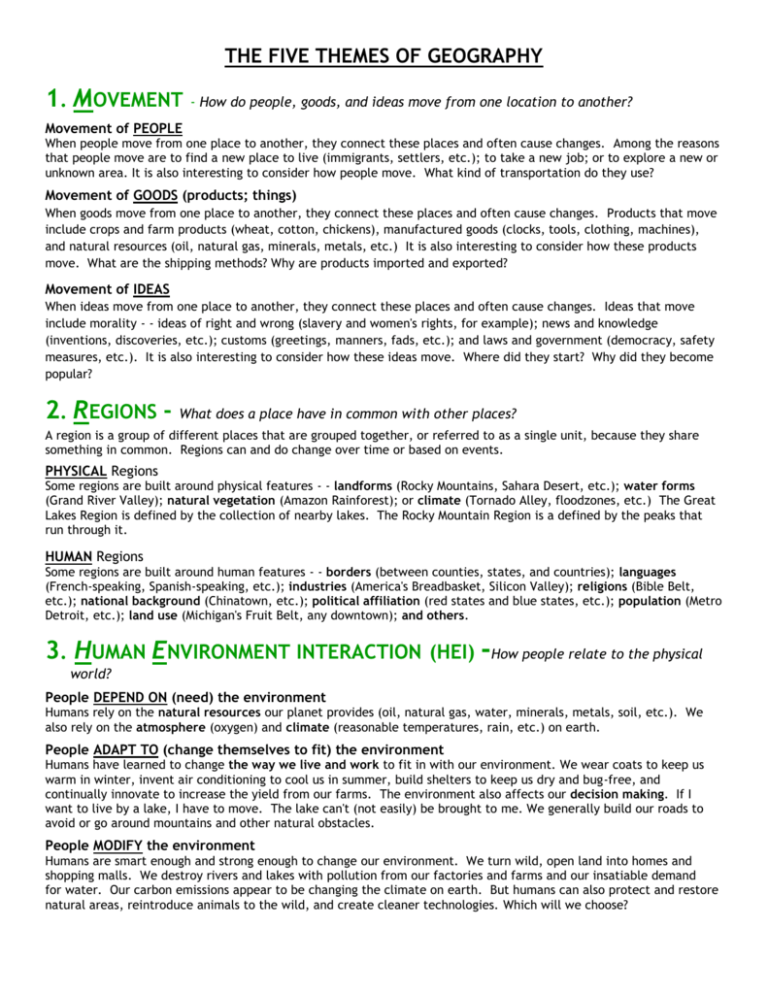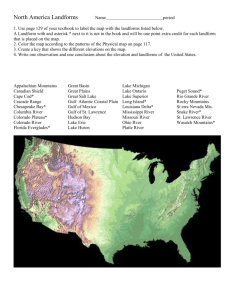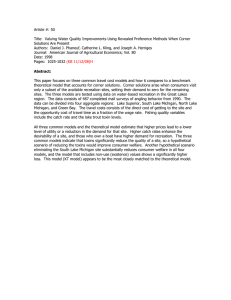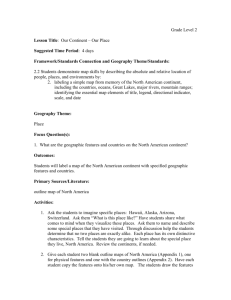
THE FIVE THEMES OF GEOGRAPHY
1. MOVEMENT - How do people, goods, and ideas move from one location to another?
Movement of PEOPLE
When people move from one place to another, they connect these places and often cause changes. Among the reasons
that people move are to find a new place to live (immigrants, settlers, etc.); to take a new job; or to explore a new or
unknown area. It is also interesting to consider how people move. What kind of transportation do they use?
Movement of GOODS (products; things)
When goods move from one place to another, they connect these places and often cause changes. Products that move
include crops and farm products (wheat, cotton, chickens), manufactured goods (clocks, tools, clothing, machines),
and natural resources (oil, natural gas, minerals, metals, etc.) It is also interesting to consider how these products
move. What are the shipping methods? Why are products imported and exported?
Movement of IDEAS
When ideas move from one place to another, they connect these places and often cause changes. Ideas that move
include morality - - ideas of right and wrong (slavery and women's rights, for example); news and knowledge
(inventions, discoveries, etc.); customs (greetings, manners, fads, etc.); and laws and government (democracy, safety
measures, etc.). It is also interesting to consider how these ideas move. Where did they start? Why did they become
popular?
2. REGIONS - What does a place have in common with other places?
A region is a group of different places that are grouped together, or referred to as a single unit, because they share
something in common. Regions can and do change over time or based on events.
PHYSICAL Regions
Some regions are built around physical features - - landforms (Rocky Mountains, Sahara Desert, etc.); water forms
(Grand River Valley); natural vegetation (Amazon Rainforest); or climate (Tornado Alley, floodzones, etc.) The Great
Lakes Region is defined by the collection of nearby lakes. The Rocky Mountain Region is a defined by the peaks that
run through it.
HUMAN Regions
Some regions are built around human features - - borders (between counties, states, and countries); languages
(French-speaking, Spanish-speaking, etc.); industries (America's Breadbasket, Silicon Valley); religions (Bible Belt,
etc.); national background (Chinatown, etc.); political affiliation (red states and blue states, etc.); population (Metro
Detroit, etc.); land use (Michigan's Fruit Belt, any downtown); and others.
3. HUMAN ENVIRONMENT INTERACTION
(HEI)
-How people relate to the physical
world?
People DEPEND ON (need) the environment
Humans rely on the natural resources our planet provides (oil, natural gas, water, minerals, metals, soil, etc.). We
also rely on the atmosphere (oxygen) and climate (reasonable temperatures, rain, etc.) on earth.
People ADAPT TO (change themselves to fit) the environment
Humans have learned to change the way we live and work to fit in with our environment. We wear coats to keep us
warm in winter, invent air conditioning to cool us in summer, build shelters to keep us dry and bug-free, and
continually innovate to increase the yield from our farms. The environment also affects our decision making. If I
want to live by a lake, I have to move. The lake can't (not easily) be brought to me. We generally build our roads to
avoid or go around mountains and other natural obstacles.
People MODIFY the environment
Humans are smart enough and strong enough to change our environment. We turn wild, open land into homes and
shopping malls. We destroy rivers and lakes with pollution from our factories and farms and our insatiable demand
for water. Our carbon emissions appear to be changing the climate on earth. But humans can also protect and restore
natural areas, reintroduce animals to the wild, and create cleaner technologies. Which will we choose?
4. LOCATION -
Where on earth is it?
ABSOLUTE Location
An absolute location is the most accurate, exact, and specific. It marks the spot. Examples of exact locations are
latitude and longitude coordinates and addresses.
RELATIVE Location
A relative location is less specific and exact, and is based on proximity to other known locations. My house is twelfth
from the end of the street on the right. Michigan is north of Ohio and Indiana; between Lake Michigan, Lake Huron,
and Lake Superior.
5. PLACE -
What is it like there?
PHYSICAL Characteristics
Physical characteristics are those based on natural features. They include landforms (mountains, sandy beaches,
earthquake activity, etc.), water forms (river rapids, waterfalls, hot springs, etc.), climate (rainy seasons, snowfall,
hurricanes, etc.); and wild plants and animals (evergreen forests, roaming elephants, etc.) The complete description
of a place will include its main physical features.
HUMAN Characteristics
Human characteristics are those based on the activities and choices of people. They include languages spoken
(German, English dialects, etc.); architecture (ranch homes, skyscrapers, tin shacks, etc.); culture (holidays, clothing,
food, etc.); religion (Christianity, Islam, mostly secular, etc.); government (democracy, monarchy, etc.);
economy (manufacturing, agriculture, banking, etc.); population density (rural, urban, suburban, etc.); and many
others. The complete description of a place will include its primary human features.
If you collect and arrange the first letters of each of the Five Themes of Geography in just the right
way, MR. HELP will appear to assist you in remembering them.
Movement
Region
Human Environment Interaction (HEI)
Location
Place
© 2003 - 2011
Orchard View Elementary (K-6)
> Mr. Czarnecki. All Rights Reserved.












